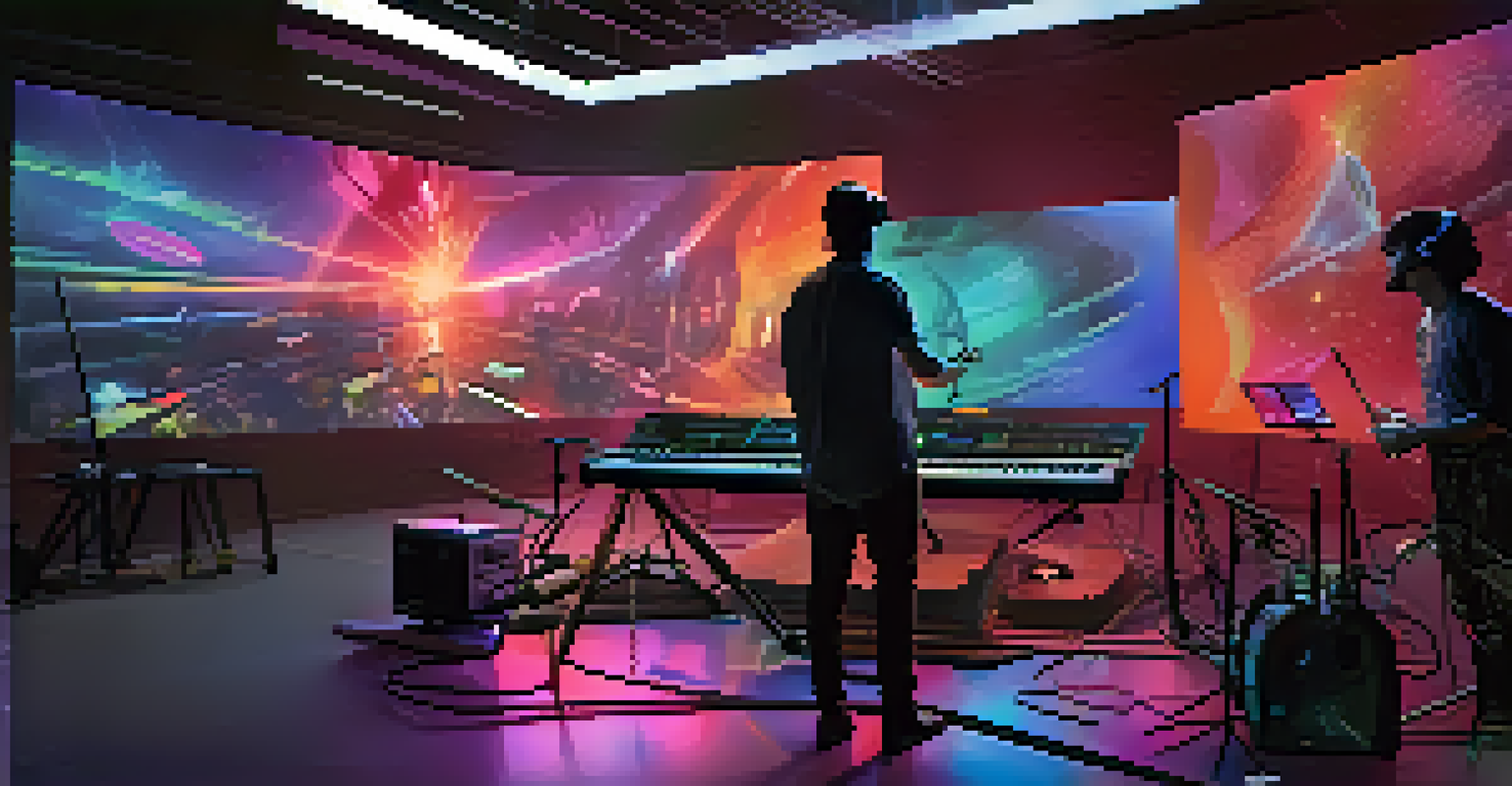How Live Streaming is Changing Music Performance Dynamics

The Rise of Live Streaming in the Music Industry
In recent years, live streaming has surged in popularity, particularly in the music industry. Artists are now able to reach global audiences without the limitations of physical venues. This shift has opened the door for both established musicians and emerging talent to showcase their work to a wider fan base, often from the comfort of their own homes.
The future of live streaming is not just about performing; it's about creating experiences that resonate with audiences globally.
Platforms like Twitch, YouTube, and Instagram Live have become vital tools for musicians aiming to connect with fans. These platforms not only allow for performances but also foster interaction, creating a more engaging experience for viewers. The ability to chat in real-time brings fans closer to their favorite artists, breaking down traditional barriers.
Moreover, the COVID-19 pandemic accelerated this trend, as many live performances were canceled. Artists quickly adapted, turning to live streaming to maintain their connection with fans and generate income. This adaptability highlights the resilience of the music industry and its willingness to embrace new technologies.
Changing Audience Dynamics and Engagement
Live streaming has fundamentally changed how audiences engage with music performances. Instead of being passive spectators, fans can actively participate by commenting, reacting, and even requesting songs in real-time. This level of interaction creates a sense of community that was often lacking in traditional concert settings.

Additionally, live streaming allows fans from different geographical locations to come together. A fan in Tokyo can enjoy a concert from a band based in London, fostering a sense of global unity among music lovers. This has not only expanded fan bases but also encouraged collaborations between artists from diverse backgrounds.
Live Streaming Revolutionizes Music
Artists can now connect with global audiences and engage fans directly from their homes through platforms like Twitch and YouTube.
The immediacy of live streaming also enhances the excitement of music discovery. Viewers can stumble upon performances that they might not have experienced in person, leading to new favorites and expanding their musical horizons. This dynamic shifts the focus from exclusive, ticketed events to an inclusive, shareable experience.
Monetization Opportunities through Live Streaming
One of the most significant impacts of live streaming on music performances is the emergence of new monetization opportunities. Artists can now generate income through virtual ticket sales, merchandise, and even fan donations during live streams. This new revenue model provides musicians with more financial stability.
Live streaming has democratized the music industry, allowing artists from all walks of life to share their sound with the world.
Platforms often have built-in features that facilitate tipping or subscription services, allowing fans to support their favorite artists directly. For instance, Twitch offers a subscription model where fans can pay a monthly fee to access exclusive content and interact more closely with artists. This approach empowers artists to cultivate a dedicated fan base.
Moreover, brands are beginning to recognize the potential of live streaming for sponsorships and partnerships. As live performances draw larger online audiences, companies are keen to collaborate with artists for promotional opportunities. This not only provides financial backing for musicians but also enhances brand visibility.
Enhanced Production Quality and Innovation
Live streaming has pushed artists to innovate in terms of production quality. With advances in technology, musicians are now equipped to deliver high-quality audio and visuals that rival traditional performances. This has led to a more immersive experience for viewers, often incorporating professional lighting, sound engineering, and camera work.
Artists are also experimenting with formats and styles in their live streams. From virtual reality concerts to themed performances, the possibilities are endless. This creativity not only keeps fans engaged but also allows artists to express themselves in new and exciting ways.
New Monetization Opportunities
Live streaming has introduced diverse revenue streams for musicians, including virtual ticket sales and fan donations.
As musicians adapt to this new landscape, they are also learning to leverage social media and marketing strategies to enhance their live stream promotions. Engaging teaser videos, behind-the-scenes content, and interactive posts can generate buzz and anticipation, leading to higher viewer turnout during performances.
The Role of Social Media in Live Streaming
Social media plays a crucial role in the success of live streaming music performances. Artists can promote their upcoming streams across various platforms, building anticipation and excitement among fans. This not only increases their reach but also enhances engagement with their audience.
Moreover, social media allows for real-time feedback and interaction, creating a dialogue between artists and fans. Musicians can respond to comments and questions during their performances, making the experience more personal and relatable. This two-way communication helps to strengthen the artist-fan relationship.
Additionally, the viral nature of social media can propel a live stream to unexpected heights. A shared clip from a performance can attract new viewers who might not have been aware of the artist beforehand. This organic growth highlights the interconnectedness of live streaming and social media in shaping music industry dynamics.
Challenges and Limitations of Live Streaming
Despite its many benefits, live streaming also presents challenges for artists. Technical issues such as poor internet connectivity or equipment malfunctions can disrupt a performance, leading to frustration for both the artist and the audience. Musicians must invest in reliable technology to minimize these risks.
Moreover, the saturation of live streaming content can make it difficult for individual artists to stand out. With countless performances happening simultaneously, capturing and maintaining viewer attention is increasingly challenging. Artists must be strategic in their approach, focusing on unique content and marketing efforts.
Social Media Amplifies Engagement
Social media enhances live streaming by enabling real-time interactions, increasing audience engagement and reach for artists.
Additionally, while live streaming can provide a sense of connection, it can’t fully replicate the energy of a live audience. Artists often thrive on the ambiance of crowd reactions, and the absence of in-person fans can impact performance dynamics. Balancing these aspects is key to creating an effective live streaming experience.
The Future of Live Streaming in Music
As technology continues to evolve, the future of live streaming in music looks promising. Innovations such as augmented reality (AR) and virtual reality (VR) are poised to enhance the live streaming experience even further. Imagine being able to attend a concert from your living room as if you were front row at the venue!
Artists are likely to continue pushing boundaries, experimenting with new formats and interactive elements that engage fans in unprecedented ways. This ongoing evolution will keep the live streaming landscape fresh and exciting, ensuring that audiences remain captivated.

Ultimately, live streaming is set to become a staple in the music industry. As artists and fans alike embrace this dynamic medium, it will redefine how music is experienced and enjoyed. The possibilities are endless, and it will be thrilling to see how this trend evolves in the years to come.